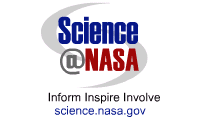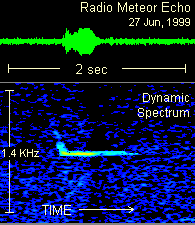 Space Science News home |
|
|
As if one meteoroid swarm weren't enough, the earth might be headed into two. The International Meteor Organization has issued an alert that a "resonant swarm" of meteoroids predicted by Dr. David Asher in 1993 could produce an outburst of Beta Taurid meteors in late June and early July 1999. Above, right: Meteor enthusiast, Stan Nelson of Roswell, NM, captured from a meteor on June 27, 1999. He used an ICOM R8500 communications receiver to monitor 217 MHz transmissions from the Navy Space Surveillance Radar located in Lake Kickapoo, TX. Both showers will be difficult to see visually. The full moon will outshine most June Boötid meteors, and the Beta Taurids are most active when the sun is above the horizon. Ham radio operators have the best chance of successfully monitoring these showers. Data reported yesterday to Science@NASA by an experienced radio meteor observer, Stan Nelson in New Mexico, suggests that enhanced meteor activity may be ongoing as of June 27, 1999. "My neighbor and fellow astronomy enthusiast, Russ Lockett, and I monitored 217 MHz radar returns for meteors this morning [June 27, 1999]", said Nelson. "We started at 5:15 am. MDT and noted 46 'blips' by 6:15 am. It was very active session and ... most of the returns appeared to be typical meteor signatures." It's impossible to say whether the echoes observed by Nelson
were meteoroids from the Beta Taurid stream or from the June
Boötid stream. They could be a mixture of both. "To identify what happens with the Beta Taurids this year, whether a swarm event or not, I would suggest radio observers should be especially alert between June 18-19 through to July 2-3 at least," says Alastair McBeath, the vice President of the International Meteor Organization. "Still later in July might be better, as some earlier results suggested a Beta Taurid maximum around July 2 or 3; this has not been found in data from the 1990s so far, however." The Beta Taurid radiant is above the horizon between roughly
03-04h local time to about 18-19h, for northern hemisphere sites
between approximately 35-55 degrees north near June 28.
The June Boötids are typically active from June 27 to July 5 with a maximum that falls on the 28th. Normally it is a very weak shower. The greatest activity levels reach 1 to 2 per hour only, but the June Boötids are remembered for strong displays in 1916, 1921, 1927, and most recently in 1998. The radiant, which is near the constellation Boötes at RA=14h52m and DECL=+58 deg, is above the horizon from about noon until 6 a.m. for mid-latitude sites in the northern hemisphere. Normally the best way to observe the June Boötids would be visually, by simply going out and looking up. However, this year the bright full moon will make visual observations very difficult, so the June Boötids like the Beta Taurids are best observed by radio methods. Nelson's observation of 46 radio pings per hour was recorded when both the Beta Taurid and June Boötid radiants were low on the horizon from his observing site. Either or both of the two showers could have been active during Nelson's observing session. Ham radio operators can make an important contribution to scientific understanding of the Beta Taurid and the June Boötid meteoroid streams by observing these showers as often as possible through early July. For hams unfamiliar with radio meteor observing techniques a brief tutorial is given below. Results may be transmitted to Dr. Tony Phillips and they will be forwarded to the appropriate scientists and meteor observing organizations.
Stan Nelson's echo, above, was obtained at 217 MHz which is usually considered to be a poor frequency for meteor observations. However, the tremendous power of the Naval Space Surveillance radar (NAVSPASUR) more than compensates for its less-than-optimum transmission frequency. NAVSPASUR is an excellent transmitter for meteor observers across the southern United States. For more information about meteor observing with NAVSPASUR, please see the Dec. 1998 Science@NASA article The Ghosts of Fireballs Past. To learn more about radio meteor observing in general, see the North American Meteor Network radio meteor tutorial. |
| Web Links |
|
The Radiometeor Audio Gallery - from the American Meteor Society The June Boötids - From Gary Kronk's Comets & Meteors Web Site The Beta Taurids - From Gary Kronk's Comets & Meteors Web Site North American Meteor Network - radio meteor tutorial North American Meteor Network - April 99 Newsletter featuring information about the Lyrids North American Meteor Network - home page Leonids Live! -site of the live webcast of the 1998 Leonids Related Stories: References: |

 Left:
Artist's concept of radio meteor observing. When fast-moving
meteoroids strike Earth's atmosphere they heat and ionize the
air in their path. The luminous ionized trails are not only visually
striking -- they also reflect radio waves. During a major meteor
shower, radio signals from TV stations, RADAR facilities, and
AM/FM transmitters are constantly bouncing off short lived meteor
trails. Whenever a meteor passes by with the correct geometry,
listeners hear a brief "blip" on the receiver's loudspeaker.
Left:
Artist's concept of radio meteor observing. When fast-moving
meteoroids strike Earth's atmosphere they heat and ionize the
air in their path. The luminous ionized trails are not only visually
striking -- they also reflect radio waves. During a major meteor
shower, radio signals from TV stations, RADAR facilities, and
AM/FM transmitters are constantly bouncing off short lived meteor
trails. Whenever a meteor passes by with the correct geometry,
listeners hear a brief "blip" on the receiver's loudspeaker.

 Left: Stan Nelson's radio meteor
echo from June 27, 1999 looks much like this "L"-shaped
reflection from a meteor on April 11, 1999 as presented in a
frequency-time plot. The slanted, nearly vertical piece is the
reflection from ionized air around the rapidly-moving meteoroid
(sometimes called the "head" of the meteor). The doppler-shifted
frequency of the reflection changes rapidly because the meteoroid
moves across the line-of-sight of the transmitter at high speed.
After the meteoroid disintegrates, all that remains is a slowly
moving trail of ionized air. The velocity of the residual trail
is low, typically no more than 0.02 km/s, compared to 30 - 70
km/s for the meteoroid. The reflection from the slowly moving
gas does not experience a significant doppler shift, so it appears
as a horizontal line (the bottom of the "L") in the
dynamic spectrum.
Left: Stan Nelson's radio meteor
echo from June 27, 1999 looks much like this "L"-shaped
reflection from a meteor on April 11, 1999 as presented in a
frequency-time plot. The slanted, nearly vertical piece is the
reflection from ionized air around the rapidly-moving meteoroid
(sometimes called the "head" of the meteor). The doppler-shifted
frequency of the reflection changes rapidly because the meteoroid
moves across the line-of-sight of the transmitter at high speed.
After the meteoroid disintegrates, all that remains is a slowly
moving trail of ionized air. The velocity of the residual trail
is low, typically no more than 0.02 km/s, compared to 30 - 70
km/s for the meteoroid. The reflection from the slowly moving
gas does not experience a significant doppler shift, so it appears
as a horizontal line (the bottom of the "L") in the
dynamic spectrum.  If you're interested in detecting
radio meteors, the procedures are relatively simple. You'll need
a good commercial radio receiver and an aerial. Although meteor
trains can reflect radio waves at almost any frequency, the best
frequencies to try are usually between 50 and 120 MHz. Many observers
use a common FM radio tunable between 88 and 108 MHz and a Yagi
FM/TV antenna. During a meteor shower tune your receiver to a
distant transmitter between 200 and 1000 miles away. Commercial
radio stations, TV stations, and radar transmitters are all suitable
if located at the correct distance. Under normal circumstances
the transmitter should be difficult or impossible to detect,
but when a meteor intervenes the signal hops over the horizon
and a brief fragment of the transmission can be heard. Depending
on the type of the transmitter it might sound like a tone, a
bit of music or voice, or simply noise. Contact lasts for as
long as the meteor train persists, usually from 100 milliseconds
to a few seconds.
If you're interested in detecting
radio meteors, the procedures are relatively simple. You'll need
a good commercial radio receiver and an aerial. Although meteor
trains can reflect radio waves at almost any frequency, the best
frequencies to try are usually between 50 and 120 MHz. Many observers
use a common FM radio tunable between 88 and 108 MHz and a Yagi
FM/TV antenna. During a meteor shower tune your receiver to a
distant transmitter between 200 and 1000 miles away. Commercial
radio stations, TV stations, and radar transmitters are all suitable
if located at the correct distance. Under normal circumstances
the transmitter should be difficult or impossible to detect,
but when a meteor intervenes the signal hops over the horizon
and a brief fragment of the transmission can be heard. Depending
on the type of the transmitter it might sound like a tone, a
bit of music or voice, or simply noise. Contact lasts for as
long as the meteor train persists, usually from 100 milliseconds
to a few seconds.  Headlines
Headlines